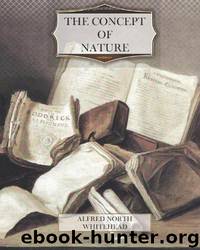The Concept of Nature by Alfred North Whitehead

Author:Alfred North Whitehead [Whitehead, Alfred North]
Language: eng
Format: epub
Tags: Epistemology, Philosophy, General, Philosophy & Social Aspects, Science, Knowledge, Nature, Science -- Philosophy, Theory of
ISBN: 9781477660645
Publisher: Cosimo, Inc.
Published: 2007-11-29T23:00:00+00:00
* * *
CHAPTER VI
CONGRUENCE
The aim of this lecture is to establish a theory of congruence. You must understand at once that congruence is a controversial question. It is the theory of measurement in space and in time. The question seems simple. In fact it is simple enough for a standard procedure to have been settled by act of parliament; and devotion to metaphysical subtleties is almost the only crime which has never been imputed to any English parliament. But the procedure is one thing and its meaning is another.
First let us fix attention on the purely mathematical question. When the segment between two points A and B is congruent to that between the two points C and D, the quantitative measurements of the two segments are equal. The equality of the numerical measures and the congruence of the two segments are not always clearly discriminated, and are lumped together under the term equality. But the procedure of measurement presupposes congruence. For example, a yard measure is applied successively to measure two distances between two pairs of points on the floor of a room. It is of the essence of the procedure of measurement that the yard measure remains unaltered as it is transferred from one position to another. Some objects can palpably alter as they move—for example, an elastic thread; but a yard measure does not alter if made of the proper material. What is this but a judgment of congruence applied to the train of successive positions of the yard measure? We know that it does not alter because we judge it to be congruent to itself in various positions. In the case of the thread we can observe the loss of self-congruence. Thus immediate judgments of congruence are presupposed in measurement, and the process of measurement is merely a procedure to extend the recognition of congruence to cases where these immediate judgments are not available. Thus we cannot define congruence by measurement.
In modern expositions of the axioms of geometry certain conditions are laid down which the relation of congruence between segments is to satisfy. It is supposed that we have a complete theory of points, straight lines, planes, and the order of points on planes—in fact, a complete theory of non-metrical geometry. We then enquire about congruence and lay down the set of conditions—or axioms as they are called—which this relation satisfies. It has then been proved that there are alternative relations which satisfy these conditions equally well and that there is nothing intrinsic in the theory of space to lead us to adopt any one of these relations in preference to any other as the relation of congruence which we adopt. In other words there are alternative metrical geometries which all exist by an equal right so far as the intrinsic theory of space is concerned.
Poincaré, the great French mathematician, held that our actual choice among these geometries is guided purely by convention, and that the effect of a change of choice would be simply to alter our expression of the physical laws of nature.
Download
This site does not store any files on its server. We only index and link to content provided by other sites. Please contact the content providers to delete copyright contents if any and email us, we'll remove relevant links or contents immediately.
| Anesthesiology | Colon & Rectal |
| General Surgery | Laparoscopic & Robotic |
| Neurosurgery | Ophthalmology |
| Oral & Maxillofacial | Orthopedics |
| Otolaryngology | Plastic |
| Thoracic & Vascular | Transplants |
| Trauma |
Periodization Training for Sports by Tudor Bompa(8169)
Why We Sleep: Unlocking the Power of Sleep and Dreams by Matthew Walker(6618)
Paper Towns by Green John(5087)
The Immortal Life of Henrietta Lacks by Rebecca Skloot(4525)
The Sports Rules Book by Human Kinetics(4290)
Dynamic Alignment Through Imagery by Eric Franklin(4116)
ACSM's Complete Guide to Fitness & Health by ACSM(3988)
Kaplan MCAT Organic Chemistry Review: Created for MCAT 2015 (Kaplan Test Prep) by Kaplan(3939)
Introduction to Kinesiology by Shirl J. Hoffman(3721)
Livewired by David Eagleman(3682)
The Death of the Heart by Elizabeth Bowen(3551)
The River of Consciousness by Oliver Sacks(3536)
Alchemy and Alchemists by C. J. S. Thompson(3448)
Bad Pharma by Ben Goldacre(3354)
Descartes' Error by Antonio Damasio(3229)
The Emperor of All Maladies: A Biography of Cancer by Siddhartha Mukherjee(3063)
The Gene: An Intimate History by Siddhartha Mukherjee(3047)
The Fate of Rome: Climate, Disease, and the End of an Empire (The Princeton History of the Ancient World) by Kyle Harper(3003)
Kaplan MCAT Behavioral Sciences Review: Created for MCAT 2015 (Kaplan Test Prep) by Kaplan(2936)
